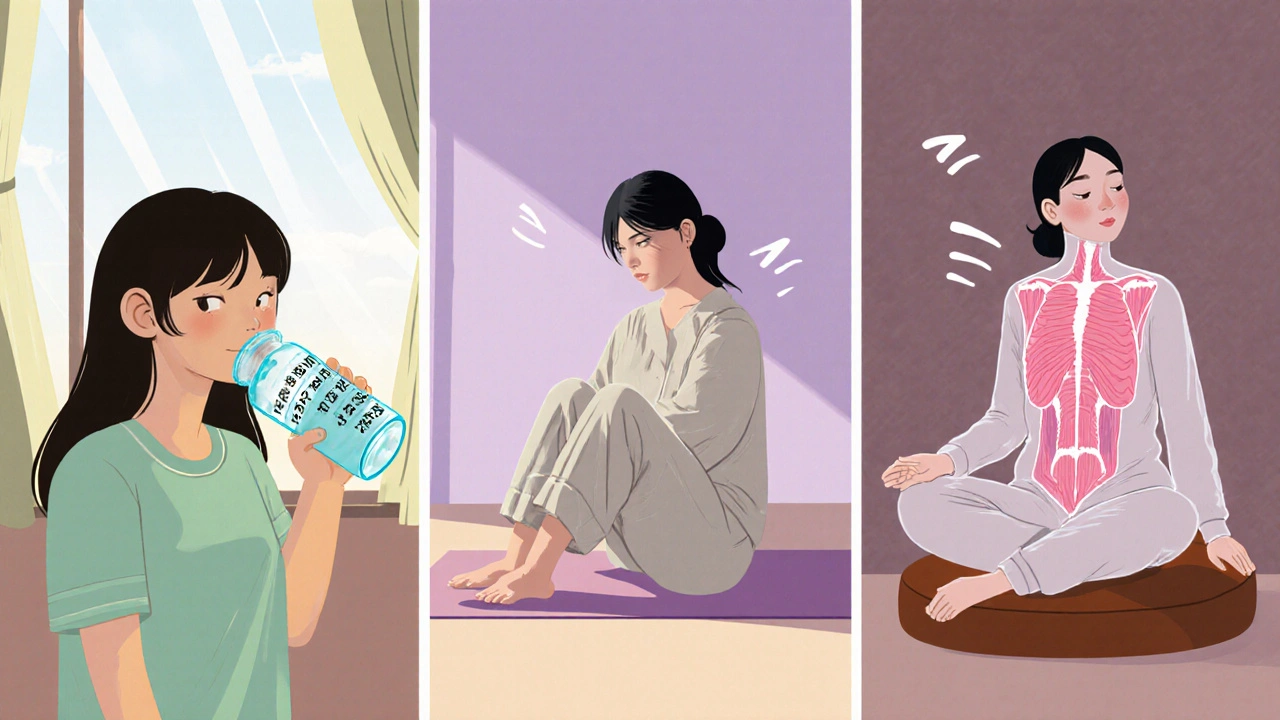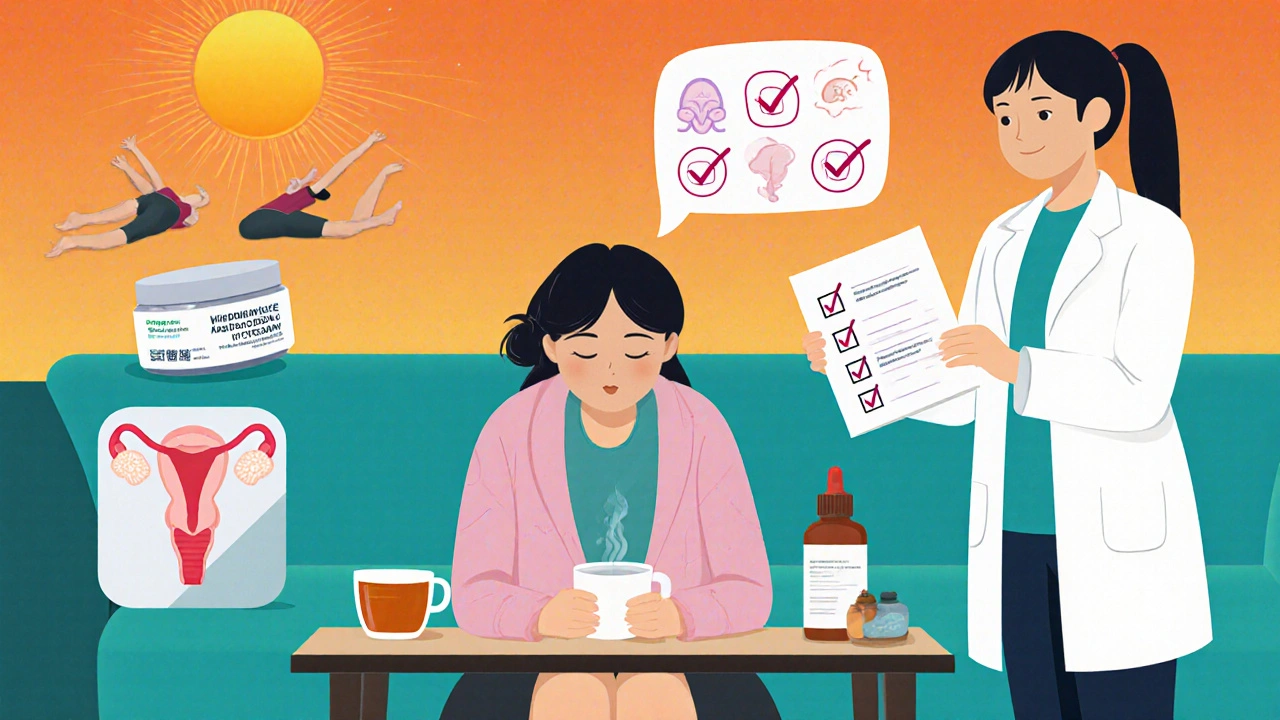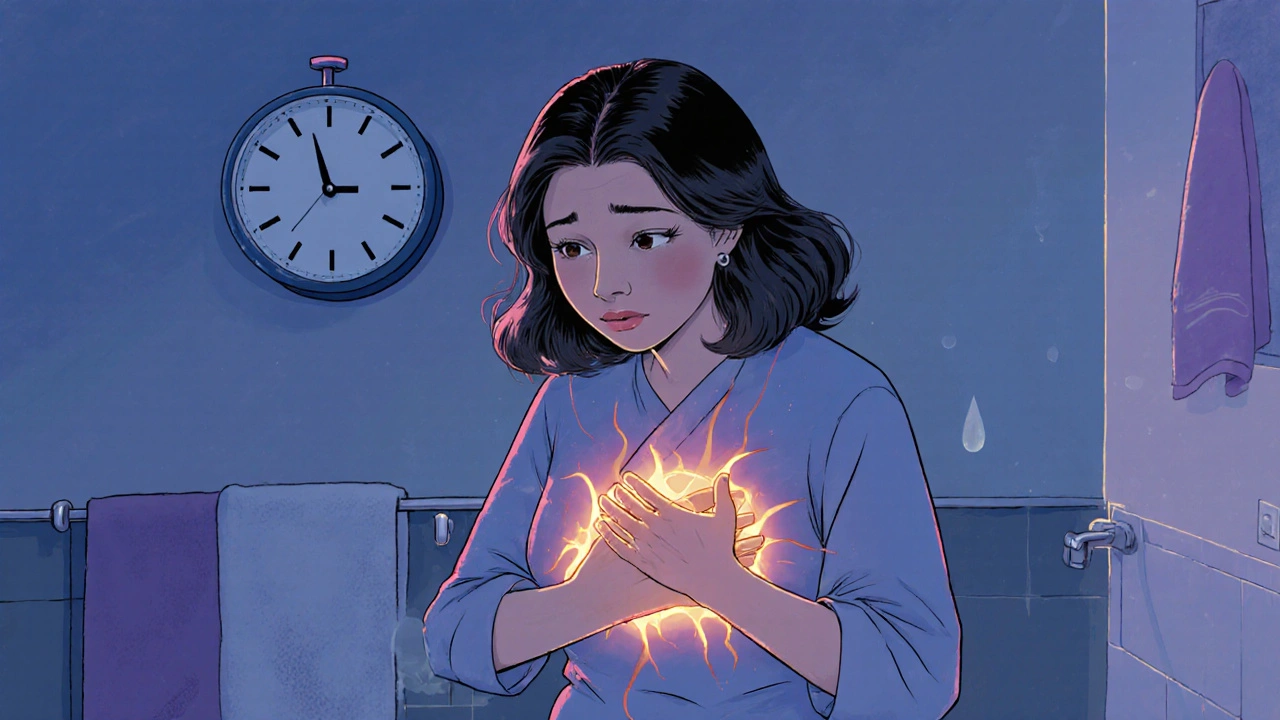Hydration Calculator for Bladder Health
Calculate Your Daily Water Needs
Proper hydration helps flush out irritants and support bladder health during menopause.
Your Hydration Plan
Aim for 1.5-2 liters (6-8 cups) daily for bladder health. Spread intake throughout the day.
Daily Hydration Guide
Following these simple habits can help reduce bladder irritation during menopause:
- Drink 1.5-2L (6-8 cups) daily Essential
- Avoid over-hydration Important
- Sip evenly throughout the day Helpful
- Limit caffeine and alcohol Avoid
Dealing with a burning, urgent need to pee while navigating the many changes of menopause can feel overwhelming. The good news? You don’t have to suffer in silence. Below are clear, step‑by‑step ways to calm menopause bladder pain and get back to a comfortable daily routine.
What Is Menopausal Bladder Pain?
Menopausal Bladder Pain is a type of urinary discomfort that occurs when estrogen levels drop during menopause. The lower estrogen makes the lining of the bladder thinner, which can trigger irritation, urgency, and occasional burning sensations.
It’s not a brand‑new condition; doctors have linked estrogen deficiency to bladder issues for decades. What’s new is the growing awareness that lifestyle tweaks and targeted therapies can make a big difference.
Spotting the Signs Early
Before you jump to treatments, make sure you know the hallmark symptoms:
- Frequent urges to urinate, often with only a few drops released.
- A burning or stinging sensation during or after voiding.
- Nighttime trips to the bathroom (nocturia).
- Feeling of incomplete emptying.
- Occasional blood‑tinged urine (should prompt a doctor’s visit).
If you notice two or more of these signs for more than a month, it’s time to take action.
Simple Lifestyle Adjustments That Help
Everyday habits have a huge impact on bladder health. Here are the most effective changes you can make right now.
Hydration, But Not Over‑Hydration
Hydration is essential for flushing out irritants, but drinking a gallon a day can overwork a sensitive bladder. Aim for about 1.5-2 liters (6-8 cups) spread evenly across the day.
Use a reusable bottle with time markers to remind yourself to sip, not gulp.
Dress for Comfort
Tight leggings and synthetic underwear can trap heat and moisture, creating a perfect environment for irritation. Switch to breathable cotton underwear and loose‑fitting pants, especially during hot weather.
Stress Management
High stress spikes the body’s cortisol levels, which can worsen urinary urgency. Simple practices like 5‑minute deep‑breathing, short walks, or a weekly yoga class can calm your nervous system and, in turn, your bladder.
Dietary Triggers to Keep an Eye On
What you eat often shows up as how you pee. Below is a quick guide to foods and drinks that commonly aggravate bladder pain.
- Caffeine: Coffee, tea, cola, and energy drinks increase bladder contractions.
- Alcohol: Even a single glass can irritate the lining.
- Citrus fruits: Oranges, lemons, and grapefruits are acidic.
- Spicy foods: Chili, hot sauce, and pepper can inflame the bladder lining.
- Artificial sweeteners: Some people report burning after diet sodas.
Try a 2‑week elimination diet: remove one category at a time and note any changes in discomfort.

Pelvic Floor Muscle Exercises (Kegels) Made Easy
Strengthening the Pelvic Floor Muscles improves bladder control and reduces urgency.
Here’s a beginner‑friendly routine:
- Sit comfortably and locate the muscles you use to stop a stream of urine.
- Contract those muscles for a count of 5 seconds, then relax for 5 seconds.
- Repeat 10 times per session, three sessions a day.
- Gradually increase holds to 10 seconds as strength improves.
Consistency beats intensity-make the exercises part of your morning, lunch, and bedtime rituals.
Medical Options: What Works and When
When lifestyle tweaks aren’t enough, consider these proven medical approaches.
Topical Estrogen Therapy
Low‑dose vaginal estrogen creams or tablets restore the bladder’s protective lining. Many women notice relief within 4-6 weeks. Discuss risks and benefits with your OB‑GYN, especially if you have a history of hormone‑sensitive cancers.
OTC Pain Relievers
Non‑prescription options like phenazopyridine (e.g., Pyridium) can dull burning for a day or two. They don’t treat the root cause but can help you get through flare‑ups.
Prescription Medications
Two drug classes are commonly used:
- Anticholinergics (e.g., oxybutynin) reduce bladder overactivity.
- PDE5 inhibitors (e.g., mirabegron) relax the bladder muscle without the dry‑mouth side effect of anticholinergics.
Both require a prescription and monitoring for side effects.
Intravesical Treatments
For stubborn cases of Interstitial Cystitis, a chronic bladder inflammation that can coexist with menopausal symptoms, doctors may inject Botox or instill dimethyl sulfoxide (DMSO) directly into the bladder.
These procedures are usually reserved for severe pain that hasn’t responded to other measures.
Physical Therapy
A specialized pelvic floor physical therapist can assess muscle imbalances and teach biofeedback techniques. Many women report a 30‑50% reduction in urgency after a few sessions.
Natural Remedies Worth Trying
If you prefer a gentler route, these options have modest evidence and few side effects.
Probiotic Supplements
Maintaining a healthy vaginal microbiome can indirectly protect the bladder. Look for LactobacillusrhamnosusGR‑1 and LactobacillusreuteriRC‑14, each at 10billion CFU daily.
Herbal Teas
Chamomile and peppermint tea have anti‑inflammatory properties. Drink a warm cup after dinner to soothe the bladder lining.
Heat Therapy
A warm sit‑z bath (not hot) for 10minutes can relax pelvic muscles and ease pain. Add a cup of Epsom salts for extra comfort.
When to Call a Doctor
Even with diligent self‑care, certain red‑flag signs demand professional evaluation:
- Blood in urine that persists.
- Pain that wakes you from sleep more than twice a night.
- Frequent UTIs (three or more in a year).
- Sudden loss of bladder control.
- Any new symptom that feels out of the ordinary.
Your urologist can run a urine culture, bladder scan, or cystoscopy to rule out infection, stones, or tumors.

Quick Checklist for Daily Relief
- Drink 1.5-2L of water, spread over the day.
- Limit caffeine and alcohol to one serving each per week.
- Practice Kegel exercises 3×daily.
- Apply a low‑dose vaginal estrogen cream if prescribed.
- Keep a bladder diary for 2weeks to spot triggers.
- Schedule a pelvic floor PT session if urgency persists.
Frequently Asked Questions
Can menopause cause urinary tract infections?
The drop in estrogen thins the bladder lining, making it easier for bacteria to adhere. While menopause doesn’t directly cause infections, it raises the risk. Staying hydrated and practicing good hygiene are key preventive steps.
Is there a link between interstitial cystitis and menopause?
Yes. Many women report that IC symptoms flare up during menopause, likely because estrogen helps protect the bladder lining. Treating hormonal deficiency often eases IC pain.
How long does topical estrogen take to work?
Most women notice a reduction in urgency and burning after 4-6weeks of consistent use. Full tissue remodeling can take up to three months.
Are over‑the‑counter pain relievers safe for long‑term use?
Short‑term use of phenazopyridine is safe, but it’s not meant for daily relief. Prolonged use can mask underlying issues and affect liver function. Talk to your doctor before using it for more than a few days.
Can pelvic floor exercises worsen pain if done incorrectly?
Yes. Over‑contracting or holding the breath while exercising can increase pelvic pressure and aggravate symptoms. Start with gentle, short holds and consider a PT session for proper technique.
Comparison of Common Treatment Options
| Option | Typical Effectiveness | Average Cost (CAD) | Common Side‑Effects |
|---|---|---|---|
| Lifestyle & diet changes | Moderate (30‑50% relief) | Low (free‑to‑implement) | None |
| Pelvic floor PT | High (50‑70% relief) | ≈$80‑$120 per session | Muscle soreness (temporary) |
| Topical estrogen | High (60‑80% relief) | ≈$30‑$50 per month | Local irritation, rare systemic effects |
| Prescription anticholinergics | Moderate‑high (40‑65% relief) | ≈$25‑$45 per month | Dry mouth, constipation, blurred vision |
| Intravesical Botox | Very high (70‑90% relief) | ≈$700‑$1000 per procedure | Urinary retention, need for clean‑intermittent catheterization |
Pick the option that fits your budget, comfort level, and how quickly you need relief. Many women start with lifestyle tweaks, add pelvic‑floor PT, and then consider hormonal or prescription routes if pain persists.
Putting It All Together
Managing bladder pain during menopause isn’t a one‑size‑fits‑all recipe. The most successful approach blends self‑care, targeted exercises, and, when needed, medical interventions. Keep a simple log, stay consistent with Kegels, and don’t ignore red‑flag symptoms. With the right plan, you can reclaim comfort and confidence even during the hottest phase of hormonal change.


6 Comments
Bladder pain during menopause is a real hassle it can ruin your day. Simple things like drinking the right amount of water help a lot. Tight clothes make the problem worse so wear loose cotton. Cutting caffeine and alcohol can calm the burning feeling. Try basic pelvic floor exercises and you’ll see improvement.
Oh dear, the agony of a burning bladder is like a secret war waging inside! The hormones are betrayed, the estrogen levels plummet, and suddenly every sip feels like a fire‑starter!!! Caffeine becomes a villain, alcohol a saboteur, and even citrus turns into a poison! We must arm ourselves with breathable cotton, gentle Kegels, and a daily diary to track the hidden culprits! Remember, the “government” of our bodies will not forgive neglect-stay vigilant!
When I first felt that relentless urge to rush to the bathroom, I thought it was just a fleeting annoyance, but it lingered like a storm cloud over my daily life. The reality is that menopause reshapes the entire urinary landscape, thinning the bladder lining and amplifying every little irritant. I started by logging every drink, every snack, and every bathroom trip in a notebook, hoping patterns would emerge from the chaos. Within a few days I noticed that my afternoon coffee was the catalyst for the most intense burning episodes, and that a simple glass of water could sometimes soothe the sting. I also experimented with my wardrobe, swapping tight leggings for loose cotton shorts, and felt an immediate sense of relief as the skin could breathe. The stress factor cannot be ignored; whenever my mind was flooded with work deadlines, the urgency spiked like wildfire, confirming the mind‑body connection. To combat this, I incorporated brief deep‑breathing sessions throughout the day, each lasting five minutes, which gradually reduced the panic‑induced urgency. Pelvic floor exercises became a ritual: I would pause during TV commercials, contract the muscles as if stopping a stream, hold for five seconds, and breathe out-repeating ten times, three times a day. Over weeks, the strength of those muscles improved, granting me better control and fewer nocturnal trips. I consulted my OB‑GYN about topical estrogen, and the low‑dose cream was a game‑changer, restoring the bladder’s protective barrier after a month of consistent use. The doctor also warned me about the risks of long‑term systemic hormones, reinforcing the wisdom of a localized approach. For those days when the pain feels unbearable, I occasionally turn to phenazopyridine, a short‑term relief that dulls the burning, but I never rely on it as a daily solution. I also tried probiotic supplements, specifically Lactobacillus strains, which seemed to fortify my vaginal flora and, indirectly, my bladder health. Herbal teas like chamomile became my nightly ritual, a soothing cup that calmed both my nerves and my bladder lining. Heat therapy-warm sit‑z baths with Epsom salts-gave my pelvic muscles a gentle relaxation after a stressful day. In moments of doubt, I reminded myself that this journey is about small, consistent actions rather than quick fixes, and that patience is the true healer. So if you’re battling bladder pain in menopause, keep a diary, stay hydrated, dress comfortably, breathe deeply, strengthen your pelvic floor, consider topical estrogen, and never shy away from seeking professional help when red flags appear :)
Great rundown of practical steps, especially the suggestion to spread water intake throughout the day rather than gulping it all at once. The reminder about breathable fabrics is spot on-tight leggings do more harm than good. Incorporating short breathing exercises before stressful meetings can really dial down the urgency spikes. Keep sharing these clear, actionable tips!
Thanks for compiling such a thorough guide; it balances medical insight with everyday habits nicely. I’d add that keeping a simple bladder diary on a phone app can make tracking triggers even easier. Remember, consistency is key, and a supportive community can boost motivation.
Reading this felt like a beacon of hope shining through a fog of discomfort! The blend of lifestyle tweaks and medical options shows that we’re not doomed to suffer silently. I love the emphasis on gentle pelvic floor work-sounds like a secret weapon against urgency. And the notion that a warm tea can calm the bladder makes me smile. Keep spreading this empowering message, because confidence grows when we take control of our bodies!
Write a comment